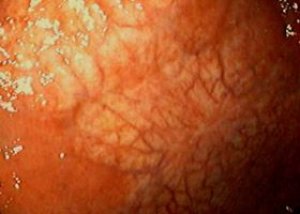
All iLive content is medically reviewed or fact checked to ensure as much factual accuracy as possible.
We have strict sourcing guidelines and only link to reputable media sites, academic research institutions and, whenever possible, medically peer reviewed studies. Note that the numbers in parentheses ([1], [2], etc.) are clickable links to these studies.
If you feel that any of our content is inaccurate, out-of-date, or otherwise questionable, please select it and press Ctrl + Enter.
Atrophic gastritis
Medical expert of the article
Last reviewed: 04.07.2025

Autoimmune metaplastic atrophic gastritis is a hereditary autoimmune disease, which is based on damage to parietal cells, leading to hypochlorhydria and decreased production of intrinsic factor. The consequence of this process is the development of atrophic gastritis, malabsorption of vitamin B 12 and often pernicious anemia. The risk of developing gastric carcinoma increases threefold. The diagnosis is established by endoscopy with biopsy. Treatment of atrophic gastritis consists of parenteral administration of vitamin B 12.
Read also:
- Gastritis
- Chronic gastritis caused by Helicobacter pylori
- Postgastrectomy gastritis
- Nonerosive gastritis
- Erosive gastritis
 [ 1 ], [ 2 ], [ 3 ], [ 4 ], [ 5 ], [ 6 ], [ 7 ], [ 8 ], [ 9 ], [ 10 ]
[ 1 ], [ 2 ], [ 3 ], [ 4 ], [ 5 ], [ 6 ], [ 7 ], [ 8 ], [ 9 ], [ 10 ]
Causes of atrophic gastritis
Patients with autoimmune metaplastic atrophic gastritis develop antibodies to parietal cells and their components (which include intrinsic factor and the proton pump H, K ATPase). Atrophic gastritis is transmitted as an autosomal dominant trait. Some patients also develop Hashimoto's thyroiditis and 50% have thyroid antibodies; conversely, parietal cell antibodies are found in 30% of patients with thyroiditis.
Deficiency of intrinsic factor leads to vitamin B 12 deficiency, which can lead to megaloblastic anemia (pernicious anemia) or neurological symptoms (subacute combined degeneration of the spinal cord).
Hypochlorhydria leads to G-cell hyperplasia and elevated serum gastrin levels (often >1000 pg/mL). Elevated gastrin levels in turn lead to hyperplasia of enterochromaffin-like cells, which sometimes transform into carcinoid tumors.
In some patients, atrophic gastritis may be associated with chronic Helicobacter pylori infection, although this relationship is not fully understood. Gastrectomy and long-term acid suppression with proton pump inhibitors cause a similar deficiency in intrinsic factor secretion.
Zones of atrophic gastritis in the body and fundus of the stomach may manifest as metaplasia. Patients with atrophic gastritis have a 3-fold higher relative risk of developing gastric adenocarcinoma.
Symptoms of atrophic gastritis
Typical complaints for chronic atrophic gastritis are:
- a feeling of heaviness, fullness in the epigastrium after eating, less often - a dull pain in the stomach after eating;
- belching of air, and in case of severe secretory insufficiency - rotten, eaten food, bitter;
- heartburn, metallic taste in the mouth;
- poor appetite;
- with severe secretory insufficiency, symptoms of atrophic gastritis appear, caused by a disruption of intestinal function (rumbling, rumbling in the abdomen, unstable stool);
- complaints caused by functional dumping syndrome: after eating food rich in carbohydrates, severe weakness, dizziness, and sweating appear.
The above symptoms of atrophic gastritis are caused by the fact that due to the low content of hydrochloric acid in the stomach, carbohydrates from food quickly enter the small intestine, are absorbed into the blood and cause a large release of insulin.
Diagnosis of atrophic gastritis
The diagnosis of atrophic gastritis is made by endoscopy with biopsy. Serum B12 levels should be measured . Anti-parietal cell antibodies may be detected in the blood, but their levels are not routinely detectable. The issue of endoscopic screening for cancer is controversial; follow-up studies are not required if the initial biopsy shows no histologic changes (eg, dysplasia) or if symptoms of atrophic gastritis are not present.
What do need to examine?
Who to contact?
Treatment of atrophic gastritis
Other than parenteral replacement of vitamin B12 deficiency , no treatment is required for atrophic gastritis.
More information of the treatment

